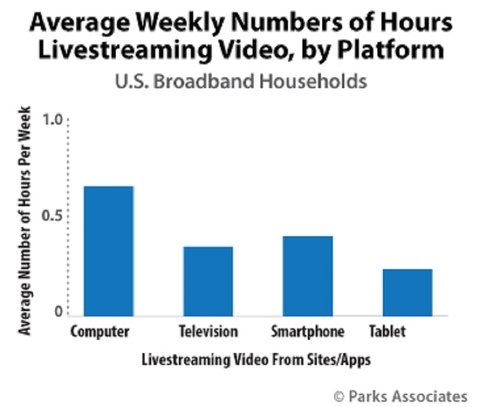Video content providers are needing to adopt new methods, including a mix of new applications and IP-based systems, to get their video to consumers, a new joint study by Parks Associates and Ooyala showed.
In the new study "Top 5 Video Trends in an IP-based World," researchers revealed what trends producers are following to deliver better storytelling, user experience and control over their content creation and delivery process.
Being able to access content from various platforms like tablet computers, online devices like Roku and smart phones, consumers expect to be able to get access to their favorite content anywhere and anytime.

RELATED: Parks: 59% of pay-TV subscribers don’t like advertisers using personal data
In partnership with Ooyala, Parks Associates cited five key trends in global video:
- Interaction: Users expect opportunities to interact with their content. Younger users that have grown up with access to the internet have become accustomed to being able to interact, state opinions and express views. The research revealed that users are accustomed to a digital world that is “clickable”—responsive to input and filled with opportunities for participation and immersion. While getting to this point is not easy, researchers said that dynamic, two-way interactivity among audiences and producers will provide deep immersion for the viewer and new monetization opportunities for video services.
- Global reach: Global, IP-based video services will be the next big revenue pool for content makers. Although the majority of content producers have been distributing content globally for a number of years, new IP-based technologies make global distribution and localization easier, particularly for short-form content and in markets where TV carriage opportunities are limited. As consumers access online sources as their initial global content source, international revenues will comprise an increasing share of producer revenues as all content producers are able to more easily “go global."
Already, such a trend is taking shape. Pop star Katy Perry streamed 96 hours of her life on tour via YouTube in June to promote her newest album, "Witness." The content reached 49 million views across 190 countries.
- Evolution of Live TV: Traditional linear television is not fading away, but rather moving to an array of connected devices. New services such as Periscope, Facebook Live and other livestreaming apps have raised consumer awareness of and the appetite for live content being consumed on connected devices. A number of companies have joined Dish Network, AT&T, Sky, and Sony in offering online pay-TV services.
Social media sites like Twitter have also been taking an active role. Twitter has signed recent deals to livestream the Wimbledon tennis tournament and the Comic-Con exhibition. Additionally, it announced plans to livestream concerts from popular artists, including Train and Marian Hill, via a partnership with Live Nation.
Parks said that shift in consumption will continue into the future. The advent of IP-based delivery enables consumers to watch live news, sports and other programming with the same freedom that they watch video on-demand today. This technology will play a prevalent role in countries whose main internet access mechanism is the main gateway they use to get live content other than over-the-air or satellite-based broadcasting.
- Choice: Consumers will continue to seek new, diverse types of content from their online service providers. While initial revenues were derived from traditional TV and movies, Parks said that new types of content are capturing an increasing share of viewing.
In particular, virtual reality (VR) and 360-degree content will be more widely produced and accepted as awareness and headset adoption rises. Another factor will be access to higher resolution video that will gain prevalence as 4K gains wider adoption and the industry overcomes format battles around HDR.
- Artificial Intelligence (AI): AI will play a key role in the success of video services. Today, the use of AI by video providers like Netflix and others has centered on simple activities related to search and recommendations. Researchers said, however, that AI’s benefits can be extended content production and enhancement.
While still early, new AI applications have begun to emerge. The English band Muse released a dynamic music video that changes daily, using AI algorithms to compile current video clips from the Internet related to the song’s lyrics, for example. A number of new AI tools can identify objects and people within videos to automatically create metadata without the need for human interaction, allowing easier use and discovery of user-generated content and identification of clips within a larger video file.
“Increased viewing on connected devices, emerging OTT services, and struggles by traditional players in a new video marketplace are all changing the value chain in content creation,” said Brett Sappington, senior director of research for Parks Associates, in a release. “Content owners, producers and creators naturally want to get their content in front of as many people as possible and are increasingly turning to cutting-edge IP technologies to prepare for the future of video production and delivery.”
However, Sappington cautioned that this transition means that content owners have to manage a number of disparate moving parts.
“There are multiple challenges in infrastructure, formatting and interoperability, but many disparate content owners, from NFL teams to late-night talk shows, are experimenting with video apps, livestreaming and other IP-based systems in order to reach connected audiences,” Sappington said.